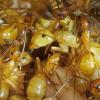Found this colony of very small ants under a brick that holds open one of our doors. they were in a cut out under the brick no further holes or anything. So I figured I collected the whole thing. I can't seem to ID any as a queen though? I'm sure I got what was there.
Maryland Howard County
Near the base of a tree.
Best I could do with Phone. Hopefully one of these shows something clear enough. ![]()
Thanks guys!























